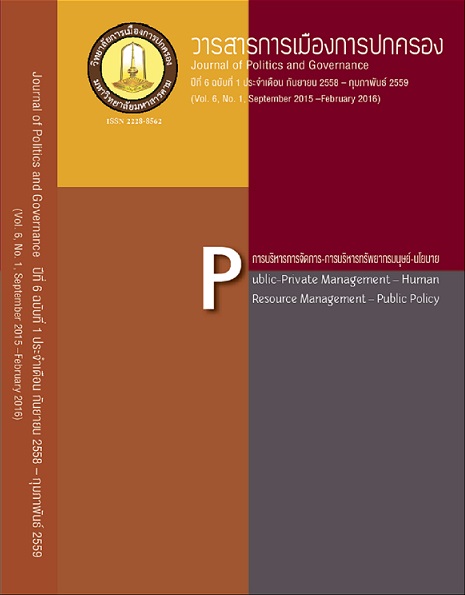Political Demonstration Management
Main Article Content
Abstract
This research aims to explore the management and strategies, which were employed in the political demonstrations by each political advocate during the prolonged Thai national political crisis (2005 – 2014). The data were collected by conducting the participatory observation and in-depth interview with 15 key informants who have involved and played an important role in the political demonstrations. The result revealed that each public demonstration apparently is created by the political motivation. The mechanisms to pursue the success of demonstration should be as follows: having clear and concrete planning and objective, holding political power and trust, performing political experience, motivating and gathering demonstrators, providing safety and appropriate demonstrating location, managing effective expenditures, having good information and effective communication, and having enough budget. Moreover, the strategy to succeed the political demonstration should have the key persons to mobilize the demonstration, producing the political discourses and making a situation for the benefit of demonstration. Interestingly, researcher found that the having political demonstration is not always indicating the conflicts in our society, in fact, people get alert and responded to political activity. From the findings, researcher suggests that Thailand should have to have the modern Political Demonstration law in order
Article Details
References
ทิพวรรณ หล่อสุวรรณรัตน์. (2552). ทฤษฎีองค์การสมัยใหม่. กรุงเทพมหานคร: บริษัท ดี.เค.ปริ้นติ้งเวิลด์.
ธงชัย สันติวงษ์. (2543). การบริหารงานบุคคล. กรุงเทพมหานคร :สำนักพิมพ์ไทยวัฒนาพาณิช.
นิตยา เงินประเสริฐศรี. (2544). ทฤษฎีองค์การ : แนวการศึกษาเชิงบูรณาการ. กรุงเทพฯ : มหาวิทยาลัย เกษตรศาสตร์.
นรินทร์ อิธิสาร.(2552). เสรีภาพในการชุมนุมในระบบกฎหมายเยอรมัน. สืบค้นเมื่อ 25 มีนาคม 2557.จาก http://www.pub-law.net/publaw/default.aspx
นวลศิริ เปาโรหิตย์. (2528).จิตวิทยาทั่วไป. กรุงเทพฯ: ภาควิชาจิตวิทยา คณะศึกษาศาสตร์ มหาวิทยาลัยรามคำแหง.
ประเวศ วะสี. (2540). ภาวะผู้นำ พยาธิสภาพในสังคมไทยและวิธีแก้ไข. ใน ผู้นำ. สงวน นิตยารัมภ์พงศ์ และสุทธิลักษณ์ สมิตะสิริ, บรรณาธิการ. กรุงเทพฯ: มติชน.
พรรณทิพย์ ศิริวรรณบุศย์. (2549). มนุษยสัมพันธ์. พิมพ์ครั้งที่ 5. กรุงเทพมหานคร: สำนักพิมพ์แห่งจุฬาลงกรณ์มหาวิทยาลัย
มานิตย์ จุมปา. (2543). รัฐธรรมนูญแห่งราชอาณาจักรไทย พุทธศักราช 2540 (ความรู้เบื้องต้น). กรุงเทพมหานคร : สำนักพิมพ์นิติธรรม.
ลิขิต ธีรเวคิน. (2543). การเมืองการปกครองไทยของไทย. สำนักพิมพ์มหาวิทยาลัยธรรมศาสตร์, 482 หน้า.
ลิขิต ธีรเวคิน. (2540). วิวัฒนาการเมืองการปกครองไทย. พิมพ์ครั้งที่ 5.กรุงเทพฯ: สำนักพิมพ์มหาวิทยาลัยธรรมศาสตร์.
วินิจ เจริญชัยยง. (2539). กฎหมายเกี่ยวกับเสรีภาพในการชุมนุมโดยสงบ.
วีรพงษ์ รามางกูล. (2556). การบริหารจัดการชุมนุมใหญ่.มติชนรายวัน ฉบับวันที่ 21 พฤศจิกายน 2556
เสกสรรค์ ประเสริฐกุล. (2547). การเมืองภาคประชาชนในระบอบประชาธิปไตยไทย. กรุงเทพ : สำนักพิมพ์อมรินทร์.
สมชาย ปรีชาศิลปะกุล. (2556). การดื้อแพ่งต่อกฎหมายของประชาชน. สืบค้นเมื่อ 5 เมษายน 2557.จาก http://www.prachatai3.
สมยศ นาวีการ. (2536). การบริหาร. กรุงเทพมหานคร: คณะพานิชศาสตร์และการบัญชีมหาวิทยาลัยธรรมศาสตร์.
สร้อยตระกูล อรรถมานะ. (2545). พฤติกรรมองค์การ: ทฤษฎีและการประยุกต์. พิมพ์ครั้งที่ 3. กรุงเทพฯ: มหาวิทยาลัยธรรมศาสตร์.
เอกพล เสียงดัง. (2550). ผลสะเทือนจากการต่อสู้ ของขบวนการคนจนและคนด้อยอำนาจ ในสังคมไทยตั้งแต่ปี 2531-2549. วิทยานิพนธ์ จุฬาลงกรณ์มหาวิทยาลัย.


